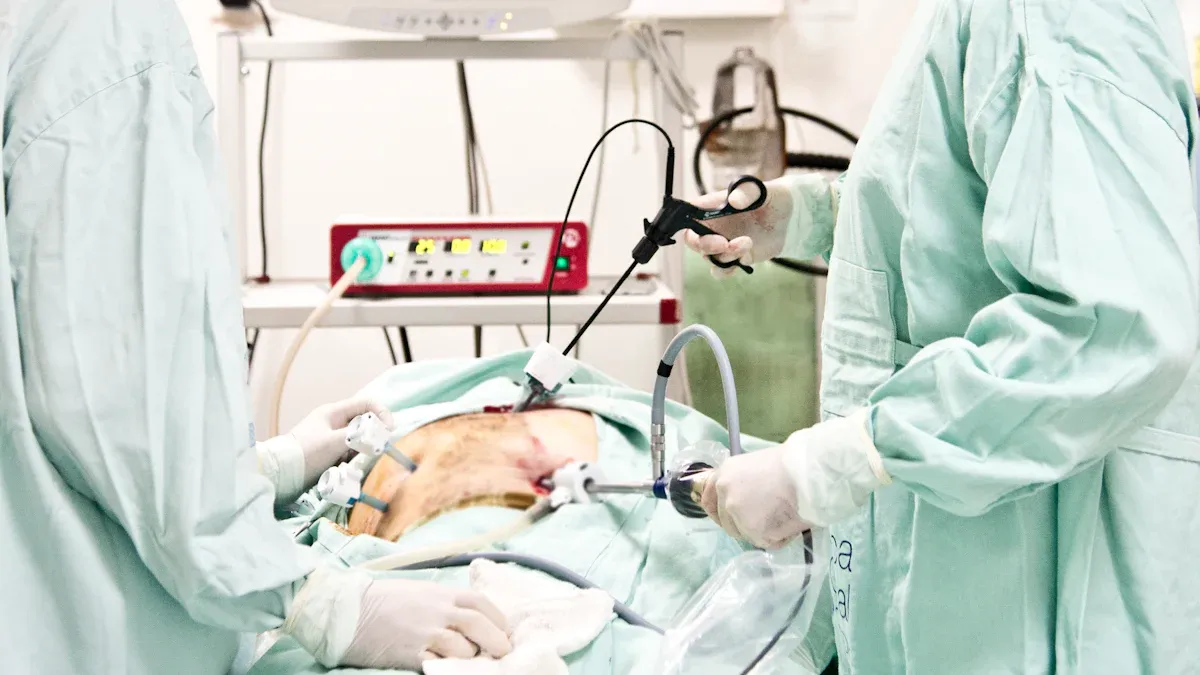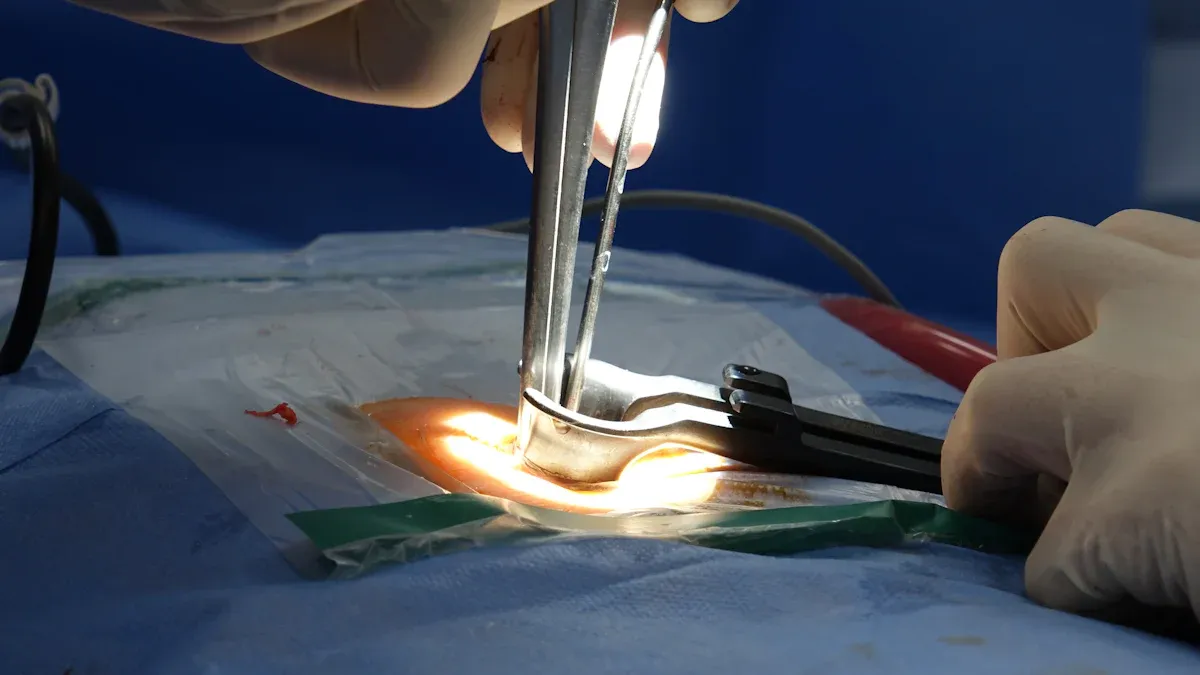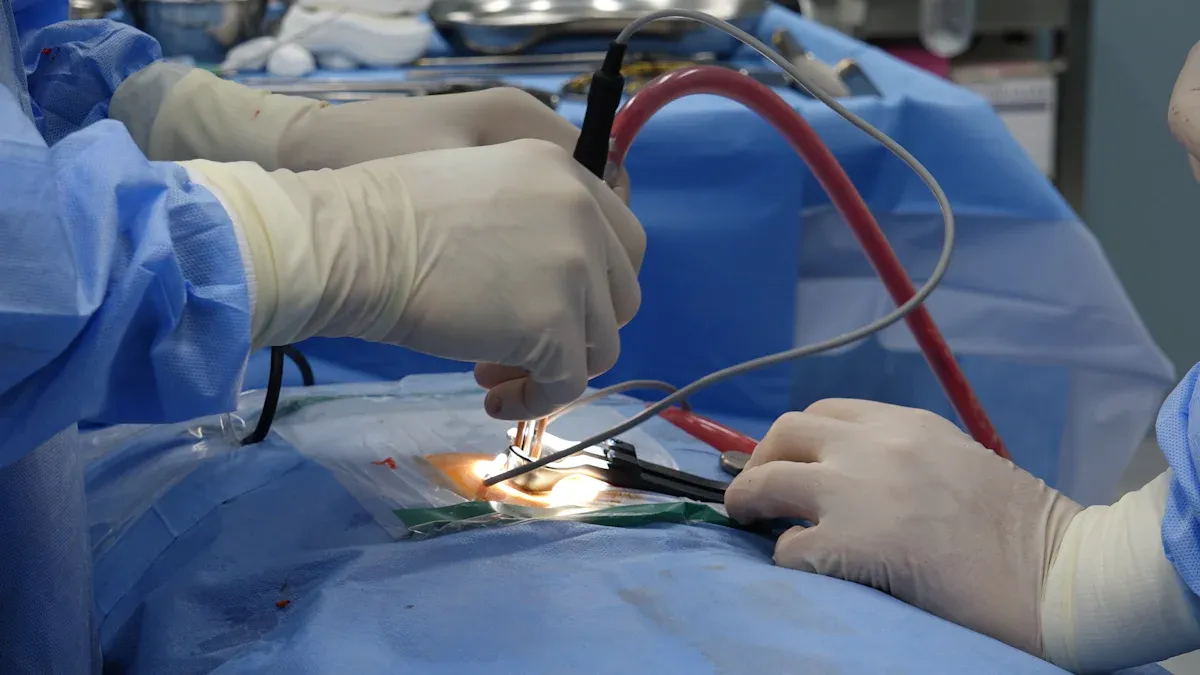How Nitinol Guidewire Tubing Enhances Minimally Invasive Surgery

Minimally invasive nitinol guidewire tubing is changing surgery. Nitinol is special because it remembers its shape. It is also very flexible and safe for the body. These features help doctors move through the body more easily. Surgeons can work with more accuracy. Patients get smaller cuts and less harm to their bodies. The DAWN and PARTNER 3 trials show nitinol-based devices help more people. More patients can do things on their own. Fewer people die compared to old ways of surgery.
Clinical Outcome
Nitinol Devices
Standard Care / Open Surgery
Functional Independence
49%
13%
One-Year Mortality Rate
1.0%
2.5%
Nitinol keeps making healthcare better. It helps patients heal and helps doctors do their jobs well.
Key Takeaways
Nitinol tubing can bend and go back to its shape. This helps doctors do safer and better surgeries. Its flexibility and strength help stop tissue damage. This means smaller cuts, less pain, and faster healing for patients. Nitinol is safe to use inside the body. It causes fewer infections and allergies than other metals. Ultra-thin nitinol tubing lets doctors use smaller tools. This makes surgeries less invasive and helps people recover faster. New nitinol medical devices and technology are making surgeries better. These will keep growing in healthcare.
Minimally Invasive Nitinol Guidewire Tubing

Nitinol is a mix of nickel and titanium. It is different from other metals. Doctors like it for minimally invasive nitinol guidewire tubing. Nitinol catheter tubing is strong and bends easily. It can also go back to its original shape. These things help doctors do surgery safely and with care. Medical tubing made from nitinol works for many types of surgeries. It is helpful in blood vessels and soft tissues.
Shape Memory
Shape memory lets nitinol catheter tubing return to its shape after bending. This happens because of a change inside the metal. Scientists have tested nitinol many times. It keeps its shape memory even after lots of use. Tests and real surgeries show nitinol stays strong and keeps its shape. Doctors use this to put stents and guidewires in the right spot. The tubing fits the body’s curves and then goes back to its set shape. This helps place devices well and lowers problems.
Nitinol’s shape memory helps doctors put stents in the right place. It also helps the tubing fit blood vessels and keeps them safe during surgery.
Superelasticity
Superelasticity means nitinol catheter tubing can bend or stretch a lot. It goes back to its shape, even after bending. This helps guidewires and tubing move through tight or twisty spaces. They do not break or get stuck. In hard surgeries, superelastic nitinol tubing lets doctors steer tools very well.
The DAWN Trial showed 49% of patients using nitinol tools could do things on their own after 90 days. Only 13% could with regular care.
The PARTNER 3 Trial found only 1.0% of people died with nitinol surgery. This is less than the 2.5% with open-heart surgery.
Nitinol tubing can bend 8–11% and still work. It can flex during surgery and not break.
These facts show superelastic nitinol catheter tubing helps patients and makes surgery safer.
Biocompatibility
Biocompatibility means a material is safe in the body. Nitinol catheter tubing works well with human tissue. Studies say nitinol has low infection and helps bones heal. It is better than some other materials like K-wires and stainless steel. Nitinol does not rust easily. It stays safe even inside the body. It does not cause bad reactions.
Implant Type | Osseous Union Rate | Implant Failure Rate | Infection Rate | Revision Surgery Need | Other Complications |
|---|---|---|---|---|---|
Memory Nitinol | 68.9% - 93.8% | 7.1% - 20.7% | 0% | Not significantly different from K-wires | Minor deformities, contractures in some cases |
K-wires | 82.1% | 7.1% | Some infections reported | Not significantly different from Nitinol | Malunion, superficial infections |
Stainless Steel (1-component) | N/A | N/A | 0% | No revision surgeries needed | Malunion rates comparable to K-wires |
This table shows nitinol guidewires and tubing are safe and work well for many surgeries.
Ultra-Thin Diameters
Ultra-thin nitinol catheter tubing lets doctors use smaller tools. These thin tubes hurt the body less and help people heal faster. Medical tubing with small diameters moves better in tight spaces. It is good for small blood vessels and soft organs.
Measurable Improvement | Description and Impact |
|---|---|
Higher Stone-Free Rates (SFR) | 6.3 Fr ultra-thin ureteroscopes showed SFR up to 95%, slightly higher than 7.5 Fr devices, indicating better stone clearance efficiency. |
Shorter Operative Times | Procedures with 6.3 Fr scopes averaged 58 minutes, shorter than larger scopes, reflecting increased efficiency. |
Improved Irrigation Flow | Smaller diameter allows larger working space within sheath, enhancing irrigation and fragment evacuation, reducing clogging. |
Reduced Ureteral Trauma | Less outward pressure and mechanical trauma on ureteral walls, lowering mucosal irritation and edema risk. |
Potential to Avoid Postoperative Stenting | Smaller scopes reduce need for routine stenting by minimizing ureteral trauma and inflammation, improving patient comfort. |
Guidewire-Free Access | In select cases, 6.3 Fr scopes enable direct ureteral access without guidewires, simplifying procedures and reducing mechanical trauma. |
Sheathless Technique | Smaller diameter facilitates sheathless use, further reducing invasiveness and enhancing recovery. |
Lower Complication Rates | Comparable or reduced complication rates observed with ultra-thin scopes, supporting safety alongside efficacy. |
Ultra-thin nitinol guidewire tubing and medical tubing help doctors do less invasive surgeries. There are fewer problems. Patients feel better and heal faster.
Benefits in Minimally Invasive Surgery
Flexibility and Kink Resistance
Nitinol is known for being flexible and not kinking. Surgeons use these features to move tools through the body. Nitinol guidewires can bend and twist but keep their shape. This helps doctors reach hard spots during surgery. The ABRE Study looked at 200 patients with blocked veins. Nitinol stents with spiral links and different strut thickness kept veins open in about 90% of cases. Only 2% of patients had big problems in the first month. Most people felt better after a year.
A computer study showed nitinol’s special strain and energy use help guidewires move smoothly in curved vessels. These features make the tip move safely and under control. In brain surgeries, nitinol guidewires bend up to 68.3° before changing shape. They go back to normal after a 90° bend. This keeps the device working well during surgery. Surgeons trust nitinol to keep its shape and work, even in tough cases.
Feature | Evidence / Data | Clinical Relevance |
|---|---|---|
Kink Resistance | Helical coil bends up to 68.3° before deforming vs. shaft at 55°; coil straightens better after 90° bend (15° vs. 23.9°) | Keeps shape under stress, lowers risk of damage during surgery |
Material Flexibility | Nitinol's platinum-nickel alloy is more flexible than stainless steel | Makes it safer to move through twisty vessels with less risk of injury |
Superelasticity | Can handle up to 6% strain and return to original shape after bending | Lets guidewire bend and stretch without damage, making it safer |
Clinical Applications | Used in neurovascular surgeries including stroke intervention, aneurysm treatment, and AVM management | Helps doctors move tools in tricky blood vessels, making surgery safer |
Biocompatibility | Durable and body-friendly, reducing risks such as swelling or blood clots | Makes it safer for patients and allows possible reuse of guidewires |
Boosting Accuracy in Surgical Tools
Nitinol’s shape memory and superelasticity help make surgical tools more accurate. These features let devices fit the body’s curves and go back to their shape. Surgeons get better control and can be more exact in surgery. Nitinol stents and implants fit the body better, which helps place them right and lowers mistakes.
AccuPath uses nitinol in tubing to keep surgeries safe and accurate. Nitinol staples and plates hold bones tight but let them move naturally. In real use, nitinol tools work well, with a 98% success rate for guidewires and 92% for catheters. Nitinol implants are rejected 30% less than older ones.
Device Type | Success Rate | Notes |
|---|---|---|
Silverway guidewire | 98% | Crosses blood vessels well |
Catheters | 92% | Works well in most surgeries |
Nitinol implants | 30% lower rejection rate | Better for the body than old materials |
Superelasticity, shape memory, and biocompatibility help keep surgery accurate. Nitinol tubing can be placed within ±2.5 microns and cut within ±10 microns. This is over ten times more exact than old ways. These features help doctors do careful work, making surgery safer for patients.
Reduced Tissue Trauma
Nitinol guidewires and tubing help doctors hurt less tissue. Their flexibility lets them move smoothly in blood vessels and soft parts. This lowers the chance of tearing or hurting healthy areas. Patients have less pain and swelling after surgery. Nitinol’s superelasticity lets devices bend and stretch without harm. Smaller cuts can be made, so the body is less disturbed.
Studies show nitinol’s special features lower the chance of problems. The tubing’s biocompatibility also means less swelling and fewer blood clots. In brain and heart surgeries, nitinol devices help doctors avoid hurting delicate parts. This focus on safety helps people heal better and have fewer problems after surgery.
Nitinol helps doctors make smaller cuts and helps patients heal faster and safer.
Faster Recovery
Patients heal faster after surgery when doctors use nitinol guidewire tubing. The material’s flexibility and shape memory allow for less invasive surgery. Surgeons make smaller cuts, so there is less pain and a lower chance of infection. Patients spend less time in the hospital and get back to normal life sooner.
Studies show a 20% better recovery for people with nitinol devices. Pain goes down, and there are fewer problems. Nitinol stents keep veins open 68% to over 90% of the time after a year. This shows nitinol helps people heal quickly and safely.
Metric | Nitinol Devices | Traditional Materials |
|---|---|---|
Recovery Improvement | 20% improvement | N/A |
Pain Level Reduction | Faster recovery | N/A |
Risk of Complications | Lower risk | N/A |
Nitinol’s special features make surgery safer and better. Patients get less trauma, heal faster, and have better results.
Applications in Minimally Invasive Surgical Tools

Stents and Catheters
Nitinol catheter tubing is very important in stents and catheters today. Doctors use these tools to treat blood vessel problems and guide other tools. Nitinol’s superelasticity and shape memory help stents fit vessel walls well. Medical tubing made from nitinol bends and flexes without breaking. This helps doctors reach hard-to-get places.
Nitinol guidewires work well in MRI-guided right heart catheterization.
Nitinol catheter tubing gives great support and is easy to move during surgery.
Medtronic uses nitinol in heart valves, leadless pacemakers, and mapping catheters. This shows nitinol can be used in many ways.
Doctors can see stents and balloons during MRI-guided surgery. This makes nitinol useful in surgical tools.
Nitinol’s biocompatibility and flexibility help lower the chance of injury during blood vessel surgery. Companies use electropolishing to make the surface smooth. This stops breaks and makes the tubing safer.
Robotic Instruments
Robotic surgery needs tools that are precise and easy to control. Nitinol gives robotic tools the flexibility and strength for tough moves. Its shape memory lets tools go back to their shape after bending.
The ORION clinical trial showed self-expanding nitinol stents are safe and work well in blood vessels.
Nitinol’s superelasticity, kink resistance, and fatigue resistance help robotic tools move with the body.
Nitinol is light, so robotic parts move faster and more accurately.
Nitinol’s biocompatibility and resistance to rust help tools last longer in robotic surgery. These features help lower problems and help patients heal faster.
Hydrophilic Coatings
Hydrophilic coatings on nitinol catheter tubing and medical tubing make tools work even better. These coatings lower friction, so tools slide easily through vessels and tissues. Thin nitinol tubing lets doctors use smaller tools. This means less injury and quicker healing.
Smaller scopes with nitinol tubing help fluids flow better and lower injury during surgery.
Hydrophilic coatings make it easier to put in devices and lower the chance of hurting vessels.
Tip: Hydrophilic coatings and thin nitinol tubing help doctors do safer and less invasive surgeries with better results.
A review of nitinol prostheses in surgery showed big improvements for patients and few problems. Nitinol is being used more in minimally invasive surgical tools. This helps both doctors and patients.
Future of Nitinol in Surgery
Emerging Technologies
Nitinol keeps helping doctors make new medical tools. Companies are making better and safer products with nitinol.
Medtronic made the Solitaire™ X nitinol neurovascular stent in 2024. More than 25,000 of these have been used in over 15 countries.
Boston Scientific made the Eluvia™ drug-eluting nitinol stent. It is now in more than 300 hospitals around the world.
Johnson & Johnson MedTech created nitinol guidewires with sensors inside. These guidewires should be in over 500 hospitals by 2025.
Smart nitinol catheters with sensors for blood pressure and temperature are being tested.
Over 150 new nitinol medical products came out between 2023 and 2024. These include self-expanding stents and neurovascular coils.
New ideas also include pulsed field ablation (PFA) systems and mapping catheters. Medtronic’s Affera PFA and Abbott’s Volt PFA work well in studies. Boston Scientific and Johnson & Johnson MedTech are making new catheters with nitinol for better control. These new tools help doctors do surgery more safely and with more accuracy.
Expanding Clinical Uses
Nitinol tubing will be even more important in healthcare soon. Studies show nitinol tools help patients get better results. For example, the DAWN Trial showed 49% of people could do things on their own after 90 days. This is much better than regular care. The PARTNER 3 Trial found only 1.0% of people died after one year with nitinol surgery. This is lower than the 2.5% with open-heart surgery.
Nitinol’s superelasticity and shape memory have been proven by tests. Devices can recover their shape by 4.16% and stretch up to 7%. In hospitals, these tools work well 97% of the time. Nitinol tubing lasts a long time and does not rust, so it is safe for long use in surgery.
Doctors now use nitinol in custom devices made by 3D printing and robots. These new ways help nitinol be used in more surgeries, like brain and stomach procedures.
Experts think nitinol will keep growing in healthcare. The market could be worth $35.4 billion by 2032, growing 7.1% each year. More surgeries, older people, and new device designs help this growth.
Aspect | Details |
|---|---|
Projected Market Size 2032 | Up to USD 35.4 billion |
CAGR (2023-2032) | 7.1% |
Growth Drivers | Minimally invasive procedures, aging population, chronic diseases |
Key Applications | Cardiovascular, orthopedic, guidewires, neurology, gastroenterology |
Market Opportunities | Personalized medicine, emerging markets, new medical fields |
Nitinol will keep making surgery and healthcare better. It will give safer and more helpful choices for patients and doctors.
Minimally invasive nitinol guidewire tubing has made surgery better for everyone. These devices help doctors work with great accuracy and last a long time. They also make it safer to move tools inside the body. Surgeons can cross blood vessels in 98 out of 100 cases. Patients have fewer problems and heal faster after surgery.
People get hurt less, spend less time in the hospital, and feel better for longer. As new ideas come out, more people will get this advanced care. This will make surgery safer and help more patients get good results.
FAQ
What makes nitinol guidewire tubing different from stainless steel?
Nitinol guidewire tubing can bend a lot and not break. It goes back to its shape after bending. Stainless steel can bend and stay bent or kink. Nitinol does not rust and works well in the body.
Is nitinol safe for patients with metal allergies?
Most people do not have problems with nitinol. The nickel in nitinol is locked inside the alloy. Studies show only a few people have allergic reactions. Doctors might test for allergies if someone is sensitive to nickel.
How does nitinol tubing help reduce recovery time?
Nitinol tubing lets doctors use smaller tools. Smaller tools cause less damage to tissue. Patients have less pain and heal faster. Hospitals see people go home sooner and have fewer problems.
Can doctors use nitinol guidewires in MRI procedures?
Yes, doctors use nitinol guidewires during MRI surgeries. Nitinol does not mess up MRI pictures. The material stays safe and easy to see, so doctors can guide tools better.
See Also
The Importance Of Nitinol Tubing In Minimally Invasive Surgery
Ways Nitinol Tubing Is Transforming Modern Medical Equipment
Nitinol Tubing's Contribution To Progress In Medical Technology
The Critical Use Of Nitinol Tubing In Advanced Healthcare
Processes Behind Manufacturing Nitinol Tubing For Medical Use

